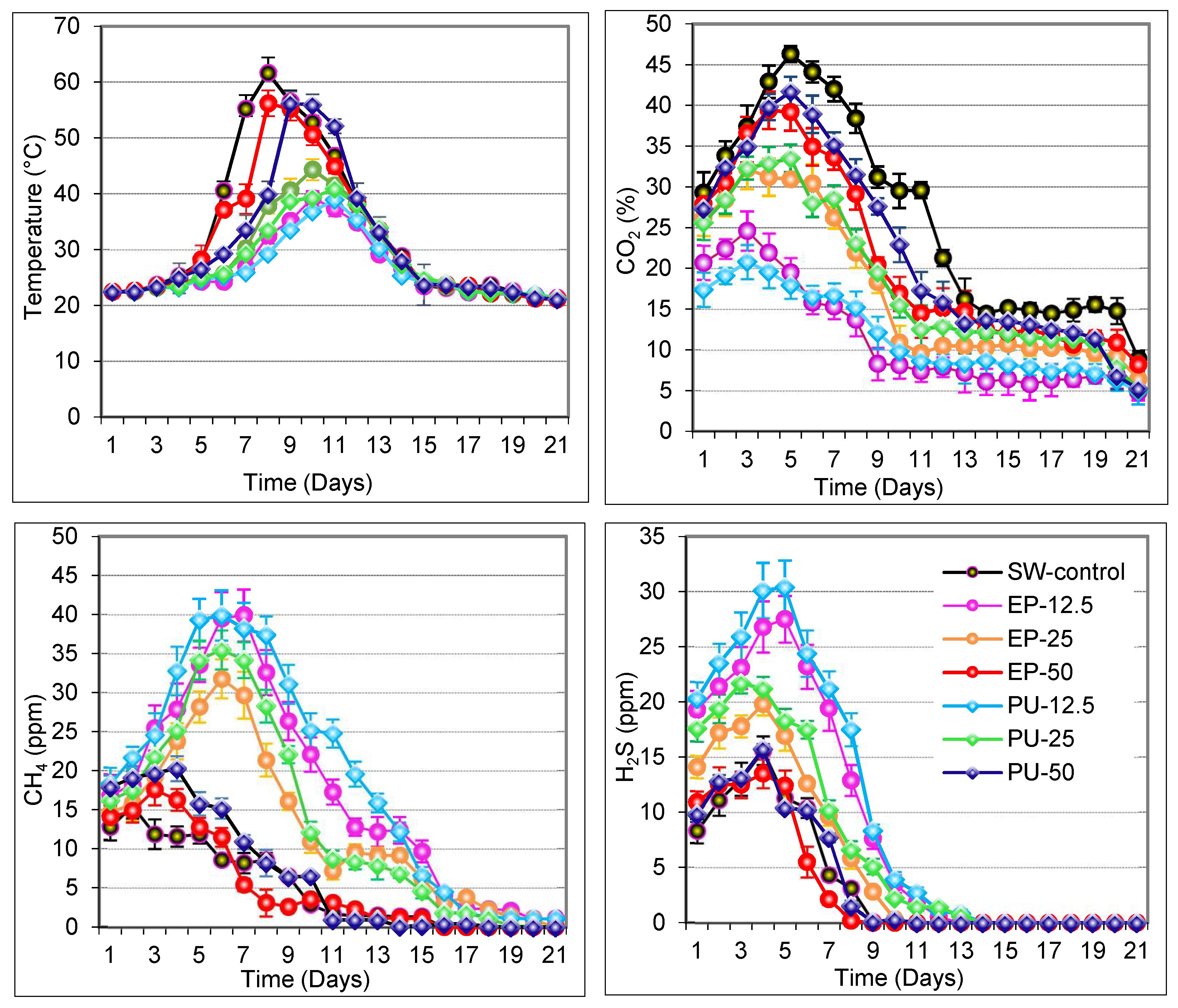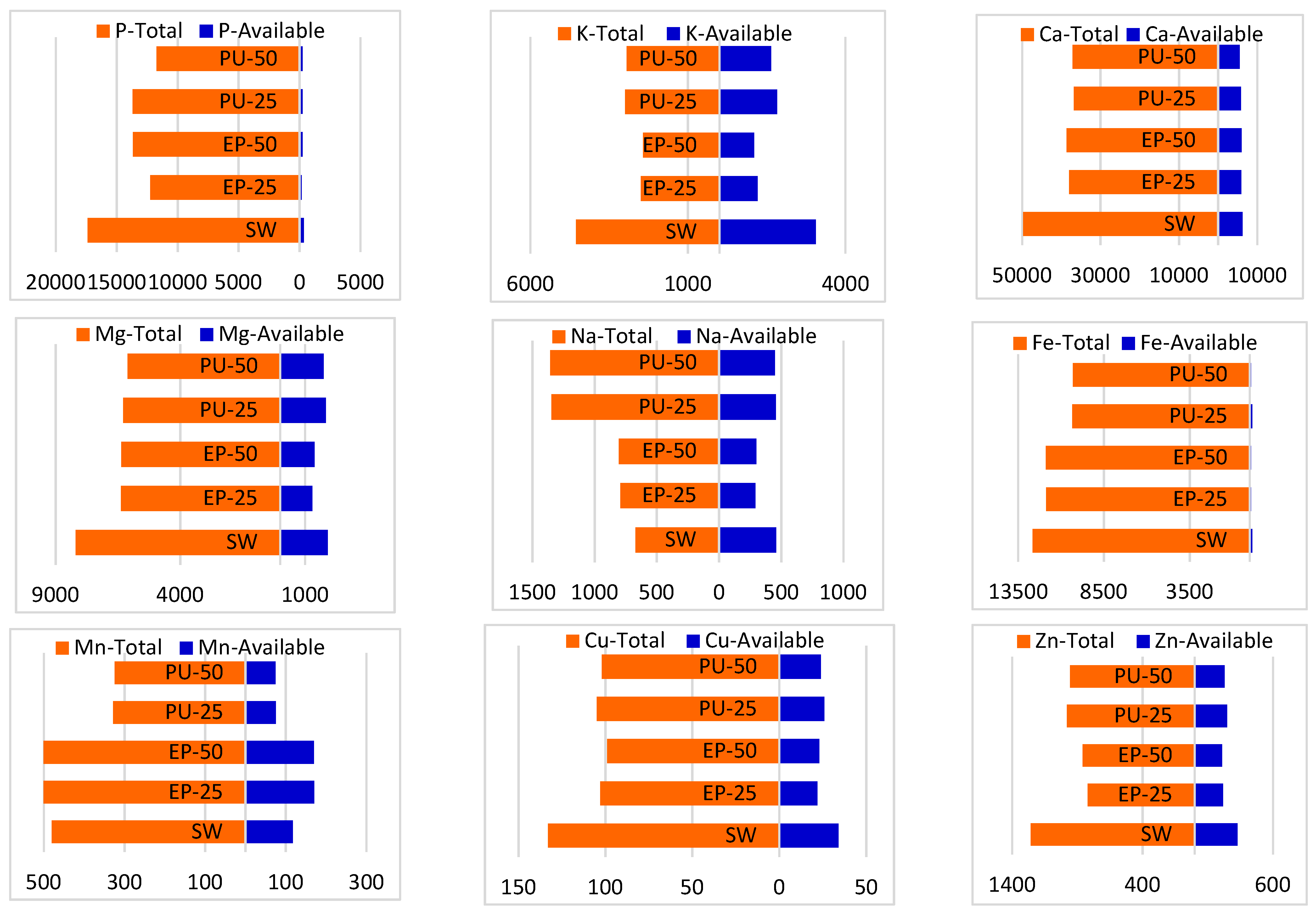Recycling Nutrient-Rich Municipal Wastes into Ready-to-Use Potting Soil: An Approach for the Sustainable Resource Circularity with Inorganic Porous Materials
Abstract
:1. Introduction
2. Materials and Methods
2.1. Material Preparation and Properties
2.2. Compost Mixes and the Compost Production Process
2.3. Analytical Methods
- GI: Germination index
- Ge: Number of germinated seeds (sample)
- Le: Length of roots (sample)
- Gc: Number of germinated seed (control)
- Lc: Length of roots (control)
2.4. Statistical Analysis
3. Results and Discussions
3.1. Temperature Change and Gaseous Evolution
3.2. Changes in Physicochemical Parameters
3.3. Germination Index
3.4. Total and Bioavailable Plant Nutrients
3.5. Correlation of Investigated Parameters
4. Conclusions
Author Contributions
Funding
Data Availability Statement
Conflicts of Interest
References
- Zhang, J.; Liang, Z.; Matsumoto, T.; Zhang, T. Environmental and economic ımplication of ımplementation scale of sewage sludge recycling systems considering carbon trading price. Sustainability 2022, 14, 8684. [Google Scholar] [CrossRef]
- Ozdemir, S.; Aslan, T.; Celebi, A.; Dede, G.; Dede, O.H. Effect of solarization on the removal of indicator microorganisms from municipal sewage sludge. Environ. Technol. 2013, 34, 1497–1502. [Google Scholar] [CrossRef] [PubMed]
- De Corato, U. Agricultural waste recycling in horticultural intensive farming systems by on-farm composting and compost-based tea application improves soil quality and plant health: A review under the perspective of a circular economy. Sci. Total Environ. 2020, 738, 139840. [Google Scholar] [CrossRef] [PubMed]
- Ozdemir, S.; Yetilmezsoy, K.; Dede, G.; Sazak, M. Application of solarization for sanitization of sewage sludge compost. J. King Saud. Uni.-Sci. 2020, 32, 443–449. [Google Scholar] [CrossRef]
- Sayara, T.; Basheer-Salimia, R.; Hawamde, F.; Sánchez, A. Recycling of organic wastes through composting: Process performance and compost application in agriculture. Agronomy 2020, 10, 1838. [Google Scholar] [CrossRef]
- Lü, H.; Chen, X.H.; Mo, C.H.; Huang, Y.H.; He, M.Y.; Li, Y.W.; Cai, Q.Y. Occurrence and dissipation mechanism of organic pollutants during the composting of sewage sludge: A critical review. Bioresour. Technol. 2021, 328, 124847. [Google Scholar] [CrossRef]
- Özbay, İ.; Özbay, B.; Akdemir, U. Biodrying for fuel recovery from sewage sludge: An integrated evaluation by ultimate and proximate analyses. Environ. Prog. Sust. Energ. 2022, 41, e13723. [Google Scholar] [CrossRef]
- Bilgin, M.; Tulun, Ş. Biodrying for municipal solid waste: Volume and weight reduction. Environ. Technol. 2015, 36, 1691–1697. [Google Scholar] [CrossRef]
- Dede, G.; Özdemir, S.; Dede, Ö.H.; Altundağ, H.; Dündar, M.Ş.; Kızıloğlu, F.T. Effects of biosolid application on soil properties and kiwi fruit nutrient composition on high-pH soil. Int. J. Environ. Sci. Technol. 2017, 14, 1451–1458. [Google Scholar] [CrossRef]
- Ozdemir, S.; Ozdemir, S.; Yetilmezsoy, K. Agro-economic and ecological assessment of poultry abattoir sludge as bio-nutrient source for walnut plantation in low-fertility soil. Environ. Prog. Sust. Energ. 2019, 38, 13225. [Google Scholar] [CrossRef]
- Ding, S.; Zhou, D.; Wei, H.; Wu, S.; Xie, B. Alleviating soil degradation caused by watermelon continuous cropping obstacle: Application of urban waste compost. Chemosphere 2021, 262, 128387. [Google Scholar] [CrossRef]
- Yüksel, O.; Kavdır, Y. Improvement of soil quality parameters by municipal solid waste compost application in clay-loam soil. Tr. J. Agric.-Food Sci. Technol. 2020, 8, 603–609. [Google Scholar] [CrossRef]
- Vida, C.; de Vicente, A.; Cazorla, F.M. The role of organic amendments to soil for crop protection: Induction of suppression of soilborne pathogens. Ann. Appl. Biol. 2020, 176, 1–15. [Google Scholar] [CrossRef]
- Ozdemir, S.; Dede, O.H.; Dede, G. Comparison of the composting performance of four different sewage sludge amendments. Compost Sci. Util. 2014, 22, 207–215. [Google Scholar] [CrossRef]
- Meng, L.; Li, W.; Zhang, S.; Zhang, X.; Zhao, Y.; Chen, L. Improving sewage sludge compost process and quality by carbon sources addition. Sci. Rep. 2021, 11, 1–8. [Google Scholar] [CrossRef]
- Turp, G.A.; Turp, S.M.; Ozdemir, S.; Yetilmezsoy, K. Vermicomposting of biomass ash with bio-waste for solubilizing nutrients and its effect on nitrogen fixation in common beans. Environ. Technol. Innov. 2021, 23, 101691. [Google Scholar] [CrossRef]
- Elsalam, H.E.A.; El-Sharnouby, M.E.; Mohamed, A.E.; Raafat, B.M.; El-Gamal, E.H. Effect of sewage sludge compost usage on corn and faba bean growth, carbon and nitrogen forms in plants and soil. Agronomy 2021, 11, 628. [Google Scholar] [CrossRef]
- Kabak, E.T.; Yolcu, O.C.; Temel, F.A.; Turan, N.G. Prediction and optimization of nitrogen losses in co-composting process by using a hybrid cascaded prediction model and genetic algorithm. Chem. Eng. J. 2022, 437, 135499. [Google Scholar] [CrossRef]
- Wang, X.; Chen, T.; Zheng, G. Perlite as the partial substitute for organic bulking agent during sewage sludge composting. Environ. Geochem. Health 2020, 42, 1517–1529. [Google Scholar] [CrossRef]
- Aygun, Z.; Aygun, M. A study on usability of Ahlat ignimbrites and pumice as radiation shielding materials, by using EpiXS code. Int. J. Environ. Sci. Technol. 2022, 19, 5675–5688. [Google Scholar] [CrossRef]
- Ozdemir, S.; Turp, S.M.; Oz, N. Simultaneous dry-sorption of heavy metals by porous adsorbents during sludge composting. Environ. Eng. Res. 2020, 25, 258–265. [Google Scholar] [CrossRef]
- Wu, C.; Li, W.; Wang, K.; Li, Y. Usage of pumice as bulking agent in sewage sludge composting. Bioresour. Technol. 2015, 190, 516–521. [Google Scholar] [CrossRef] [PubMed]
- Shan, G.; Li, W.; Gao, Y.; Tan, W.; Xi, B. Additives for reducing nitrogen loss during composting: A review. J. Clean. Prod. 2021, 307, 127308. [Google Scholar] [CrossRef]
- Ahn, T.I.; Son, J.E. Application of an alternative nutrient replenishment method to electrical conductivity-based closed-loop soilless cultures of sweet peppers. Horticulturae 2022, 8, 295. [Google Scholar] [CrossRef]
- Bonaguro, J.E.; Coletto, L.; Sambo, P.; Nicoletto, C.; Zanin, G. Environmental analysis of sustainable production practices applied to cyclamen and zonal geranium. Horticulturae 2021, 7, 8. [Google Scholar] [CrossRef]
- Kelley, A.J.; Campbell, D.N.; Wilkie, A.C.; Maltais-Landry, G. Compost composition and application rate have a greater ımpact on spinach yield and soil fertility benefits than feedstock origin. Horticulturae 2022, 8, 688. [Google Scholar] [CrossRef]
- Zhang, B.; Xu, Z.; Jiang, T.; Huda, N.; Li, G.; Luo, W. Gaseous emission and maturity in composting of livestock manure and tobacco wastes: Effects of aeration intensities and mitigation by physiochemical additives. Environ. Technol. Innov. 2020, 19, 100899. [Google Scholar] [CrossRef]
- Liu, L.; Ye, Q.; Wu, Q.; Liu, T.; Peng, S. Effect of biochar addition on sludge aerobic composting and greenbelt utilization. Environ. Technol. Innov. 2021, 21, 101279. [Google Scholar] [CrossRef]
- Li, X.; Shi, X.S.; Yang, Z.M.; Xu, X.H.; Guo, R.B. Effects of recyclable ceramsite as the porous bulking agent during the continuous thermophilic composting of dairy manure. J. Clean. Prod. 2019, 217, S344–S351. [Google Scholar] [CrossRef]
- Weligama Thuppahige, R.T.; Gheewala, S.H.; Babel, S. Environmental impact of organic fraction of municipal solid waste treatment by composting in Sri Lanka. J. Mater. Cycles Waste Manag. 2022, 24, 189–199. [Google Scholar] [CrossRef]
- Sülük, K.; Tosun, İ.; Ekinci, K. Co-composting of two-phase olive-mill pomace and poultry manure with tomato harvest stalks. Environ. Technol. 2017, 38, 923–932. [Google Scholar] [CrossRef]
- Awasthi, M.K.; Wang, Q.; Ren, X.; Zhao, J.; Huang, H.; Awasthi, S.K.; Zhang, Z. Role of biochar amendment in mitigation of nitrogen loss and greenhouse gas emission during sewage sludge composting. Bioresour. Technol. 2016, 219, 270–280. [Google Scholar] [CrossRef]
- Phoungthong, K.; Zhang, H.; Shao, L.M.; He, P.J. Leaching characteristics and phytotoxic effects of sewage sludge biochar. J. Mater. Cycles Waste Manag. 2018, 20, 2089–2099. [Google Scholar] [CrossRef]
- Eneji, A.E.; Honna, T.; Yamamoto, S.; Masuda, T. Influence of composting conditions on plant nutrient concentrations in manure compost. J. Plant Nutr. 2003, 26, 1595–1604. [Google Scholar] [CrossRef]
- Turan, N.G.; Akdemir, A.; Ergun, O.N. Removal of volatile organic compounds by natural materials during composting of poultry litter. Bioresour. Technol. 2009, 100, 798–803. [Google Scholar] [CrossRef]
- Machado, R.M.; Alves-Pereira, I.; Robalo, M.; Ferreira, R. Effects of municipal solid waste compost supplemented with inorganic nitrogen on physicochemical soil characteristics, plant growth, nitrate content, and antioxidant activity in Spinach. Horticulturae 2021, 7, 53. [Google Scholar] [CrossRef]





| Parameter (mg/kg). | Method |
|---|---|
| Total P | ISO 22036 (Detection with ICP-OES) |
| Total Na | |
| Total K | |
| Total Ca | |
| Total Mg | |
| Total Fe | |
| Total Cu | |
| Total Mn | |
| Total Zn | |
| Available P | TS 8341:1990 (Ammonium Acetate Method) |
| Available Na | |
| Available K | |
| Available Ca | |
| Available Mg | |
| Available Fe | TS EN ISO 14870:2004 Extraction of Trace Elements with DTPA ISO 22036:2008 |
| Available Cu | |
| Available Mn | |
| Available Zn | |
| Total Kjeldahl N | Kjeldahl method |
| Parameters | Mean Square | F Values | p Values |
|---|---|---|---|
| Temperature change | 235.08 | 2.02 * | 0.044 |
| CO2 evolution | 676.49 | 7.96 ** | <0.001 |
| CH4 generation | 877.83 | 11.73 ** | <0.001 |
| H2S generation | 279.76 | 6.11 ** | <0.001 |
| Organic matter | 392.95 | 23.89 ** | <0.001 |
| Moisture content | 672.66 | 84.28 ** | <0.001 |
| pH | 0.06 | 19.60 ** | <0.001 |
| Total Kjeldahl nitrogen | 0.56 | 29.13 ** | <0.001 |
| Germination Index | 641.95 | 39.97 ** | <0.001 |
Disclaimer/Publisher’s Note: The statements, opinions and data contained in all publications are solely those of the individual author(s) and contributor(s) and not of MDPI and/or the editor(s). MDPI and/or the editor(s) disclaim responsibility for any injury to people or property resulting from any ideas, methods, instructions or products referred to in the content. |
© 2023 by the authors. Licensee MDPI, Basel, Switzerland. This article is an open access article distributed under the terms and conditions of the Creative Commons Attribution (CC BY) license (https://creativecommons.org/licenses/by/4.0/).
Share and Cite
Dede, C.; Ozer, H.; Dede, O.H.; Celebi, A.; Ozdemir, S. Recycling Nutrient-Rich Municipal Wastes into Ready-to-Use Potting Soil: An Approach for the Sustainable Resource Circularity with Inorganic Porous Materials. Horticulturae 2023, 9, 203. https://doi.org/10.3390/horticulturae9020203
Dede C, Ozer H, Dede OH, Celebi A, Ozdemir S. Recycling Nutrient-Rich Municipal Wastes into Ready-to-Use Potting Soil: An Approach for the Sustainable Resource Circularity with Inorganic Porous Materials. Horticulturae. 2023; 9(2):203. https://doi.org/10.3390/horticulturae9020203
Chicago/Turabian StyleDede, Cemile, Hasan Ozer, Omer Hulusi Dede, Ahmet Celebi, and Saim Ozdemir. 2023. "Recycling Nutrient-Rich Municipal Wastes into Ready-to-Use Potting Soil: An Approach for the Sustainable Resource Circularity with Inorganic Porous Materials" Horticulturae 9, no. 2: 203. https://doi.org/10.3390/horticulturae9020203






